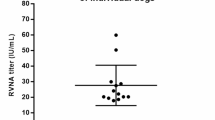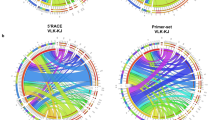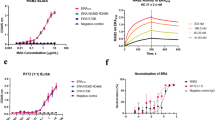Abstract
Aim:
To transform the human anti-rabies virus glycoprotein (anti-RABVG) single-chain variable fragment (scFv) into a Fab fragment and to analyze its immunological activity.
Methods:
The Fab gene was amplified using overlap PCR and inserted into the vector pComb3XSS. The recombinant vector was then transformed into E coli Top10F' for expression and purification. The purified Fab was characterized using SDS-PAGE, Western blotting, indirect ELISA, competitive ELISA, and the fluorescent antibody virus neutralization test (FAVN), respectively, and examined in a Kunming mouse challenge model in vivo.
Results:
A recombinant vector was constructed. The Fab was expressed in soluble form in E coli Top10F'. Specific binding of the Fab to rabies virus was confirmed by indirect ELISA and immunoprecipitation (IP). The neutralizing antibody titer of Fab was 10.26 IU/mL. The mouse group treated with both vaccine and human rabies immunoglobulin (HRIG)/Fab091 (32 IU/kg) showed protection against rabies, compared with the control group (P<0.05, Logrank test).
Conclusion:
The antibody fragment Fab was shown to be a neutralizing antibody against RABVG. It can be used together with other monoclonal antibodies for post-exposure prophylaxis of rabies virus in future studies.
Similar content being viewed by others
Log in or create a free account to read this content
Gain free access to this article, as well as selected content from this journal and more on nature.com
or
References
Komarova AV RE, Borman AM, Brocard M, England P, Tordo N, Hershey JW, et al. Rabies virus matrix protein interplay with eIF3, new insights into rabies virus pathogenesis. Nucleic Acids Res 2007; 35: 1522–32.
Margalith M VA . Sustained protective rabies neutralizing antibody titers after administration of cationic lipid-formulated pDNA vaccine. Genet Vaccines Ther 2006; 4: 2.
Irie T KA . Studies on the different conditions for rabies virus neutralization by monoclonal antibodies #1-46-12 and #7-1-9. J Gen Virol 2002; 83: 3045–53.
Bordignon J CF, Ferreira SC, Caporale GM, Lima Filho JH, Zanetti CR . Calculating rabies virus neutralizing antibodies titres by flow cytometry. Rev Inst Med Trop Sao Paulo 2002; 44: 151–4.
Li C, Lin H, Liu XJ, Wang ZC, Zhou ZX, Chen LR, et al. Construction and screening of human immunized phage-display antibody libraries against rabies virus. Acta Univ Med Nanjing (Natural Sci) 2010; 30: 575–8.
Kovalskaya N HR . Expression and functional characterization of the plant antimicrobial snakin-1 and defensin recombinant proteins. Protein Expr Purif 2009; 63: 12–7.
Zhu J, Zhao P, Jiao YJ, Wang X, Cao BL, Feng ZQ, et al. Affinity maturation and characterization of internalized human anti-Met recombinant antibody Fab. Prog Biochem Biophys 2007; 34: 73–9.
Barbas CF 3rd, Kang AS, Lerner RA, Benkovic SJ . Assembly of combinatorial antibody libraries on phage surfaces: the gene III site. Proc Natl Acad Sci USA 1991; 88: 7978–82.
Bellamy SR, Milsom SE, Kovacheva YS, Sessions RB, Halford SE . A switch in the mechanism of communication between the two DNA-binding sites in the Sfi I restriction endonuclease. J Mol Biol 2007; 373: 1169–83.
Corisdeo S WB . Functional expression and display of an antibody Fab fragment in Escherichia coli: study of vector designs and culture conditions. Protein Expr Purif 2004; 34: 270–9.
Sam brook J RD . Molecular Cloning: A Laboratory Manual. 3 ed. Cold Spring Harbor, New York: Cold Spring Harbor Laboratory Press; 2001.
Chatterjee DK ED . Enhanced soluble protein expression using two new fusion tags. Protein Expr Purif 2006, 46: 122–9.
Xiong L, Zhang AX, Li YQ, Zhang DW, Cao BL, Zhu J, et al. Reconstitution of human anti-Met genetic engineering antibody scFv. Acta Univ Med Nanjing (Natural Sci) 2009; 29: 605–17.
Zhao MP, Li YZ, Guo ZQ, Zhang XX, Chang WB . A new competitive enzyme-linked immunosorbent assay (ELISA) for determination of estrogenic bisphenols. Talant 2002; 57: 1205–10.
Tai HC, Campanile N, Ezzelarab M, Cooper DK, Phelps C . Measurement of anti-CD154 monoclonal antibody in primate sera by competitive inhibition ELISA. Xenotransplantation 2006; 13: 566–70.
Li WH MX, Qi ZT, Ni W, Zhu SY, Fang F . Proteomic analysis of differently expressed proteins in human hepatocellular carcinoma cell lines HepG2 with transfecting hepatitis B virus X gene. Chin Med J (Engl) 2009; 122: 15–23.
Cliquet F AM, Sagné L . Development of a fluorescent antibody virus neutralisation test (FAVN test) for the quantitation of rabies-neutralising antibody. J Immunol Methods 1998; 212: 79–87.
Zhang SF, Cao L, Zhang F, Li HT, Li QZ, Zhang RL . Establishment and application of hybridomas producing anti-rabies nucleoprotein McAb and fluorescent antibody virus neutralization test. Chin J Lab Med 2006; 29: 554–7.
Goudsmit J MW, Weldon WC, Niezgoda M, Hanlon CA, Rice AB, Kruif J, et al. Comparison of an anti-rabies human monoclonal antibody combination with human polyclonal anti-rabies immuneglobulin. J Infect Dis 2006, 193: 796–801.
de Kruif J BA, Marissen WE, Kramer RA, Throsby M, Rupprecht CE, Goudsmit J . A human monoclonal antibody cocktail as a novel component of rabies postexposure prophylaxis. Annu Rev Med 2007; 58: 359–68.
Prosniak M FM, Hanlon CA, Rupprecht CE, Hooper DC, Dietzschold B . Development of a cocktail of recombinant-expressed human rabies virus-neutralizing monoclonal antibodies for postexposure prophylaxis of rabies. J Infect Dis 2003; 188: 53–6.
Bakker AB, Marissen WE, Kramer RA, Rice AB, Weldon WC, Niezgoda M, et al. Novel human monoclonal antibody combination effectively neutralizing natural rabies virus variants and individual in vitro escape mutants. J Virol 2005; 79: 9062–8.
Bakker AB, Python C, Kissling CJ, Pandya P, Marissen WE, Brink MF, et al. First administration to humans of a monoclonal antibody cocktail against rabies virus: safety, tolerability, and neutralizing activity. Vaccine 2008; 26: 5922–7.
Goudsmit J MW, Weldon WC, Niezgoda M, Hanlon CA, Rice AB, Kruif J, et al. Comparison of an anti-rabies human monoclonal antibody combination with human polyclonal anti-rabies immuneglobulin. J Infect Dis 2006; 193: 796–801.
Satpathy DM, Sahu T, Behera TR . Equine rabies immunoglobulin: a study on its clinical safety. J Indian Med Assoc 2005; 103: 238, 241–2.
Ray K, Embleton MJ, Jailkhani BL, Bhan MK, Kumar R . Selection of single chain variable fragments (scFv) against the glycoprotein antigen of the rabies virus from a human synthetic scFv phage display library and their fusion with the Fc region of human IgG1. Clin Exp Immunol 2001; 125: 94–101.
Henderikx P, Coolen-van Neer N, Jacobs A, van der Linden E, Arends JW, Müllberg J, et al. A human immunoglobulin G1 antibody originating from an in vitro-selected Fab phage antibody binds avidly to tumor-associated MUC1 and is efficiently internalized. Am J Pathol 2002; 160: 1597–608.
Beran J, Honegr K, Banzhoff A, Malerczyk C . Potency requirements of rabies vaccines administered intradermally using the Thai Red Cross regimen: investigation of the immunogenicity of serially diluted purified chick embryo cell rabies vaccine. Vaccine 2005; 23: 3902–7.
Kelly MP, Lee FT, Tahtis K, Power BE, Smyth FE, Brechbiel MW, et al. Tumor targeting by a multivalent single-chain Fv (scFv) anti-Lewis Y antibody construct. Cancer Biother Radiopharm 2008; 23: 411–23.
Goncalvez AP, Chien CH, Tubthong K, Gorshkova I, Roll C, Donau O, et al. Humanized monoclonal antibodies derived from chimpanzee Fabs protect against Japanese encephalitis virus in vitro and in vivo. J Virol 2008; 82: 7009–21.
Mazor Y, Van Blarcom T, Iverson BL, Georgiou G . E-clonal antibodies: selection of full-length IgG antibodies using bacterial periplasmic display. Nat Protoc 2008; 3: 1766–77.
Mazor Y, Van Blarcom T, Mabry R, Iverson BL, Georgiou G . Isolation of engineered full-length antibodies from libraries expressed in Escherichia coli. Nat Biotechnol 2007; 25: 563–5.
Cardoso TC, Silva LH, Albas A, Ferreira HL, Perri SH . Rabies neutralizing antibody detection by indirect immunperoxidase serum neutralization assay performed on chicken embryo related cell line. Mem Inst Oswaldo Cruz 2004; 99: 531–4.
Houimel M, Dellagi K . Isolation and characterization of human neutralizing antibodies to rabies virus derived from a recombinant immune antibody library. J Virol Methods 2009; 161: 205–15.
Bender E, Woof JM, Atkin JD, Barker MD, Bebbington CR, Burton DR . Recombinant human antibodies: linkage of a Fab fragment from a combinatorial library to an Fc fragment for expression in mammalian cell culture. Hum Antibodies Hybridomas 1993; 4: 74–9.
Cheung SC, Dietzschold B, Koprowski H, Notkins AL, Rando RF . A recombinant human Fab expressed in Escherichia coli neutralizes rabies virus. J Virol 1992; 66: 6714–20.
Thullier P, Lafaye P, Megret F, Deubel V, Jouan A, Mazie JC . A recombinant Fab neutralizes dengue virus in vitro. J Biotechnol 1999; 69: 183–90.
Barbas CF 3rd, Crowe JE Jr, Cababa D, Jones TM, Zebedee SL, Murphy BR, et al. Human monoclonal Fab fragments derived from a combinatorial library bind to respiratory syncytial virus F glycoprotein and neutralize infectivity. Proc Natl Acad Sci USA 1992; 89: 10164–8.
Lamarre A, Talbot PJ . Protection from lethal corona virus infection by immunoglobulin fragments. J Immunol 1995; 154: 3975–84.
Acknowledgements
This investigation was supported by the National High Technology Research and Development Program, China (No 2007AA02Z418). We would like to thank Chun-yan GU for valuable technical assistance and Johnson HUANG for revising the manuscript.
Author information
Authors and Affiliations
Corresponding authors
Rights and permissions
About this article
Cite this article
Li, C., Zhang, F., Lin, H. et al. Generation and characterization of the human neutralizing antibody fragment Fab091 against rabies virus. Acta Pharmacol Sin 32, 329–337 (2011). https://doi.org/10.1038/aps.2010.209
Received:
Accepted:
Published:
Issue date:
DOI: https://doi.org/10.1038/aps.2010.209
Keywords
This article is cited by
-
Predicting 3D heterogeneous in situ stress field of Gaoshangpu Oilfield northern area, Nanpu Sag, Bohai Bay Basin, China
Arabian Journal of Geosciences (2020)
-
3D numerical simulation of heterogeneous in situ stress field in low-permeability reservoirs
Petroleum Science (2019)
-
Stress distribution and its influencing factors of bottom-hole rock in underbalanced drilling
Journal of Central South University (2018)



